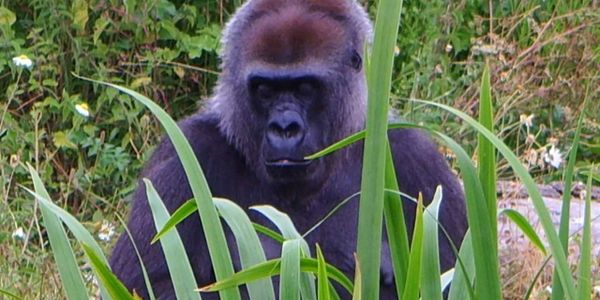Welcome to gorillawoods.com
Focus on Captive Gorillas
Focus on Captive Gorillas

Gorillas are found in equatorial Africa and are divided into four subspecies. The gorillas you see in zoos are western lowland gorillas - Gorilla gorilla gorilla. (Talk about taxonomic simplicity!) Gorilla social groups typically contain one breeding male (the silverback), multiple breeding females, and their offspring. This type of social group is referred to as single male polygyny. In some populations, the "surplus" adult males form bachelor groups. Gorillas are vegetarians (herbivores), who sometimes add insects to their diet for extra protein.
photo: Ernie's family, Bronx Zoo, 2018
photo credit: Donna Barry

Sue Woods, primatologist. In 1970 I received a BA in anthropology and French from Wichita State University, and later an MA (1988) and PhD (1992) in anthropology from University of Colorado. My doctoral dissertation was entitled "Implementation and Evaluation of a Behavioral Enrichment Program for Captive Gorillas, With an Emphasis on Tool Behaviors," and this research was the beginning of my gorilla journey. I have continued to observe captive gorillas and document their intelligence and behaviors, captive stereotypies, transfers between facilities, maternal behaviors, and the benefits of captive enrichment. For 20 years I taught courses in biological anthropology at University of Colorado, from which I am now retired.
photo credit: Jerry Billette

This website is dedicated, with great respect and affection, to all gorillas in captivity. They inspire us to care about their endangered brethren in Africa, but they didn't volunteer for that job. Gorillas are sentient beings, each with a distinct personality. It has been my absolute privilege and pleasure to get to know and do research with some very special captive gorillas, and I look forward to introducing them to you here.
I'm excited to share with you my research results and my photos of these amazing animals. I hope this information will be helpful for gorillas in zoos and the folks who care for them.
As you may have experienced, it's a challenge to take good photos of gorillas in a zoo setting. This is one of my favorite photos: the lovely Romina at Bristol Zoo in England, taken in 1992. All photos have been taken by me, unless otherwise noted.
Copyright © 2018 gorillawoods - All Rights Reserved.
Powered by GoDaddy